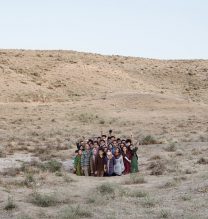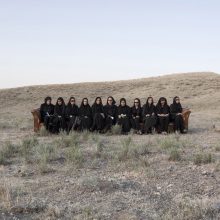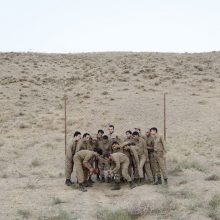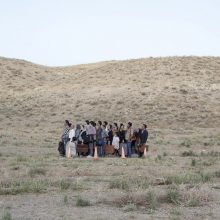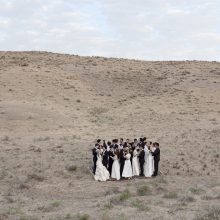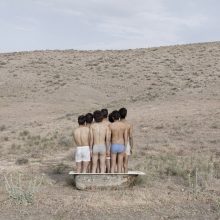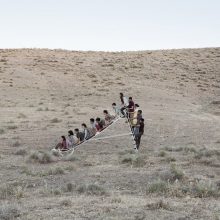Iran, Untitled
Gohar Dashti
Gohar Dashti has depicted a counter-narrative of her homeland both in form and essence of the work in her recent series. She started “creation” of her photographs with Today’s Life and War” (2008) and followed the same path with “Slow Decay” (2010) and “Volcano” (2012). In these three series, consistent with the main flow of the staged photography, she has tried to embed a narrative form in the background of her photos, although this narration fades away gradually. In “Iran Untitled”, albeit there is a spatial unity which makes the formation of narration possible and this very title of the series discloses a meta-narrative, yet here the place is no longer a place but a non-place. The place is a desert in the middle of nowhere. On the other hand, narrations of any forms are usually based on language, though in Dashti’s Iran, people’s relationships are not essentially vocalized. People’s relationships are the relationships of bodies. A group in a hole has silently raised hands in objection. Another group, on a carpet which is not a magic carpet is holding a marriage ceremony. The women are quietly grieving. The youth is lying anxiously on a mattress waiting for an incident. Other young people seem to be trapped on a slide. Perhaps a few teenagers in a bathtub are longing to be bathed by the sun. Another hopeless group is getting ready for a journey. Finally, the young soldiers have launched a war game in the borderless border. The photographer has set pieces of this land on the desert. The horizon of this vast desert slowly moves up and bends down and lets the people breathe.
Dashti has reshot this situation in the midst of the open desert and stuck a piece of her imagination on this unyielding land. It seems as if the pieces of her imagination are chunks of the reality of her homeland. These chunks are dismissed rather cramped in this extensive land, not telling a story but giving a glimpse. The reality is beyond the compactness and extensiveness. We do not see the event; we are left dangling to make up the story ourselves. We wonder whether Dashti’s pictures are a clue for our stories or they make us bewildered. to make Dashti’s “desert” is not a barren desert and neither is our homeland.
